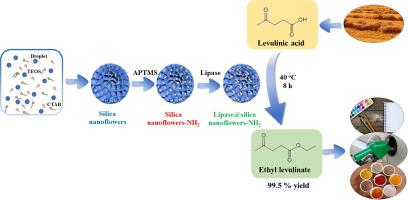当前位置:
X-MOL 学术
›
Fuel Process. Technol.
›
论文详情
Our official English website, www.x-mol.net, welcomes your
feedback! (Note: you will need to create a separate account there.)
Selective production of ethyl levulinate from levulinic acid by lipase-immobilized mesoporous silica nanoflowers composite
Fuel Processing Technology ( IF 7.2 ) Pub Date : 2020-12-01 , DOI: 10.1016/j.fuproc.2020.106578 Boyu Jia , Chunguang Liu , Xinhua Qi
Fuel Processing Technology ( IF 7.2 ) Pub Date : 2020-12-01 , DOI: 10.1016/j.fuproc.2020.106578 Boyu Jia , Chunguang Liu , Xinhua Qi

|
Abstract Mesoporous silica nanoflowers bearing -NH2 groups were synthesized by the hydrolysis of tetraethyl orthosilicate (TEOS) with reverse microemulsion method, following with the grafting of -NH2 groups by the post modification with (3-Aminopropyl) trimethoxysilane (APTMS). The lipase from C. antarctica was immobilized on the as-synthesized amino-grafted mesoporous silica nanoflowers to fabricate the lipase-immobilized mesoporous silica nanoflowers composite, which was applied for the catalytic transformation of biomass-derived levulinic acid to biofuel ethyl levulinate (EL), and exhibited excellent catalytic activity. An ethyl levulinate yield as high as 99.5% could be achieved at 40 °C in 8 h reaction time, which was much higher than that catalyzed by the free lipase (67.9%) under the identical conditions. The immobilized lipase showed good stability and recyclability that ethyl levulinate yields above 68% could be remained after seven recycle times. This work represents a novel strategy to construct the immobilized biocatalyst for the production of bio-based chemicals.
中文翻译:

脂肪酶固定化介孔二氧化硅纳米花复合材料从乙酰丙酸中选择性生产乙酰丙酸乙酯
摘要 以原硅酸四乙酯(TEOS)为原料,采用反相微乳液法水解,再用(3-氨基丙基)三甲氧基硅烷(APTMS)进行后修饰接枝-NH2基团,合成了带有-NH2基团的介孔二氧化硅纳米花。将来自 C. antarctica 的脂肪酶固定在合成的氨基接枝介孔二氧化硅纳米花上以制备脂肪酶固定的介孔二氧化硅纳米花复合材料,该复合材料用于将生物质衍生的乙酰丙酸催化转化为生物燃料乙酰丙酸乙酯 (EL) ,并表现出优异的催化活性。在 40°C 下,8 小时反应时间内乙酰丙酸乙酯的产率可高达 99.5%,远高于相同条件下游离脂肪酶催化的产率(67.9%)。固定化脂肪酶表现出良好的稳定性和可回收性,7次回收后乙酰丙酸乙酯的产率仍可保持在68%以上。这项工作代表了一种构建用于生产生物基化学品的固定化生物催化剂的新策略。
更新日期:2020-12-01
中文翻译:

脂肪酶固定化介孔二氧化硅纳米花复合材料从乙酰丙酸中选择性生产乙酰丙酸乙酯
摘要 以原硅酸四乙酯(TEOS)为原料,采用反相微乳液法水解,再用(3-氨基丙基)三甲氧基硅烷(APTMS)进行后修饰接枝-NH2基团,合成了带有-NH2基团的介孔二氧化硅纳米花。将来自 C. antarctica 的脂肪酶固定在合成的氨基接枝介孔二氧化硅纳米花上以制备脂肪酶固定的介孔二氧化硅纳米花复合材料,该复合材料用于将生物质衍生的乙酰丙酸催化转化为生物燃料乙酰丙酸乙酯 (EL) ,并表现出优异的催化活性。在 40°C 下,8 小时反应时间内乙酰丙酸乙酯的产率可高达 99.5%,远高于相同条件下游离脂肪酶催化的产率(67.9%)。固定化脂肪酶表现出良好的稳定性和可回收性,7次回收后乙酰丙酸乙酯的产率仍可保持在68%以上。这项工作代表了一种构建用于生产生物基化学品的固定化生物催化剂的新策略。











































 京公网安备 11010802027423号
京公网安备 11010802027423号